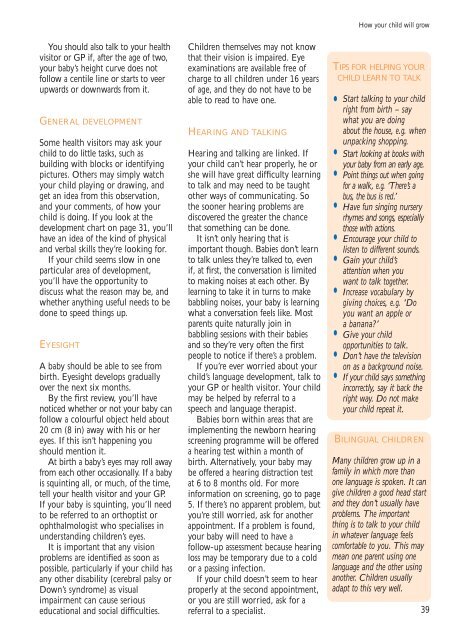Here - Health Promotion Agency
Here - Health Promotion Agency
Here - Health Promotion Agency
Create successful ePaper yourself
Turn your PDF publications into a flip-book with our unique Google optimized e-Paper software.
How your child will grow<br />
You should also talk to your health<br />
visitor or GP if, after the age of two,<br />
your baby’s height curve does not<br />
follow a centile line or starts to veer<br />
upwards or downwards from it.<br />
GENERAL DEVELOPMENT<br />
Some health visitors may ask your<br />
child to do little tasks, such as<br />
building with blocks or identifying<br />
pictures. Others may simply watch<br />
your child playing or drawing, and<br />
get an idea from this observation,<br />
and your comments, of how your<br />
child is doing. If you look at the<br />
development chart on page 31, you’ll<br />
have an idea of the kind of physical<br />
and verbal skills they’re looking for.<br />
If your child seems slow in one<br />
particular area of development,<br />
you’ll have the opportunity to<br />
discuss what the reason may be, and<br />
whether anything useful needs to be<br />
done to speed things up.<br />
EYESIGHT<br />
A baby should be able to see from<br />
birth. Eyesight develops gradually<br />
over the next six months.<br />
By the first review, you’ll have<br />
noticed whether or not your baby can<br />
follow a colourful object held about<br />
20 cm (8 in) away with his or her<br />
eyes. If this isn’t happening you<br />
should mention it.<br />
At birth a baby’s eyes may roll away<br />
from each other occasionally. If a baby<br />
is squinting all, or much, of the time,<br />
tell your health visitor and your GP.<br />
If your baby is squinting, you’ll need<br />
to be referred to an orthoptist or<br />
ophthalmologist who specialises in<br />
understanding children’s eyes.<br />
It is important that any vision<br />
problems are identified as soon as<br />
possible, particularly if your child has<br />
any other disability (cerebral palsy or<br />
Down’s syndrome) as visual<br />
impairment can cause serious<br />
educational and social difficulties.<br />
Children themselves may not know<br />
that their vision is impaired. Eye<br />
examinations are available free of<br />
charge to all children under 16 years<br />
of age, and they do not have to be<br />
able to read to have one.<br />
HEARING AND TALKING<br />
Hearing and talking are linked. If<br />
your child can’t hear properly, he or<br />
she will have great difficulty learning<br />
to talk and may need to be taught<br />
other ways of communicating. So<br />
the sooner hearing problems are<br />
discovered the greater the chance<br />
that something can be done.<br />
It isn’t only hearing that is<br />
important though. Babies don’t learn<br />
to talk unless they’re talked to, even<br />
if, at first, the conversation is limited<br />
to making noises at each other. By<br />
learning to take it in turns to make<br />
babbling noises, your baby is learning<br />
what a conversation feels like. Most<br />
parents quite naturally join in<br />
babbling sessions with their babies<br />
and so they’re very often the first<br />
people to notice if there’s a problem.<br />
If you’re ever worried about your<br />
child’s language development, talk to<br />
your GP or health visitor. Your child<br />
may be helped by referral to a<br />
speech and language therapist.<br />
Babies born within areas that are<br />
implementing the newborn hearing<br />
screening programme will be offered<br />
a hearing test within a month of<br />
birth. Alternatively, your baby may<br />
be offered a hearing distraction test<br />
at 6 to 8 months old. For more<br />
information on screening, go to page<br />
5. If there’s no apparent problem, but<br />
you’re still worried, ask for another<br />
appointment. If a problem is found,<br />
your baby will need to have a<br />
follow-up assessment because hearing<br />
loss may be temporary due to a cold<br />
or a passing infection.<br />
If your child doesn’t seem to hear<br />
properly at the second appointment,<br />
or you are still worried, ask for a<br />
referral to a specialist.<br />
TIPS FOR HELPING YOUR<br />
CHILD LEARN TO TALK<br />
•<br />
Start talking to your child<br />
right from birth – say<br />
what you are doing<br />
about the house, e.g. when<br />
unpacking shopping.<br />
• Start looking at books with<br />
your baby from an early age.<br />
• Point things out when going<br />
for a walk, e.g. ‘There’s a<br />
bus, the bus is red.’<br />
• Have fun singing nursery<br />
rhymes and songs, especially<br />
those with actions.<br />
• Encourage your child to<br />
listen to different sounds.<br />
• Gain your child’s<br />
attention when you<br />
want to talk together.<br />
• Increase vocabulary by<br />
giving choices, e.g. ‘Do<br />
you want an apple or<br />
a banana?’<br />
• Give your child<br />
opportunities to talk.<br />
• Don’t have the television<br />
on as a background noise.<br />
• If your child says something<br />
incorrectly, say it back the<br />
right way. Do not make<br />
your child repeat it.<br />
BILINGUAL CHILDREN<br />
Many children grow up in a<br />
family in which more than<br />
one language is spoken. It can<br />
give children a good head start<br />
and they don’t usually have<br />
problems. The important<br />
thing is to talk to your child<br />
in whatever language feels<br />
comfortable to you. This may<br />
mean one parent using one<br />
language and the other using<br />
another. Children usually<br />
adapt to this very well.<br />
39

















